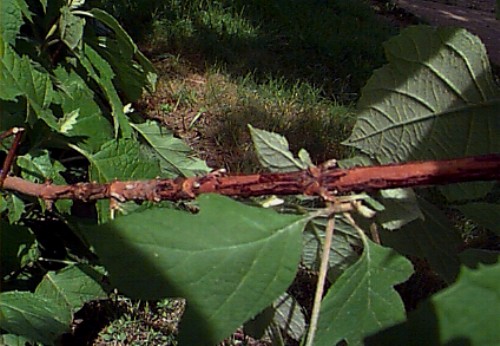Hydrangea quercifolia
Oakleaf Hydrangea
Hydrangeaceae
ExpandHabitat
- native to southeastern United States
- zone 5
Habit and Form
- a deciduous flowering shrub
- stoloniferous and multistemmed
- individual stems branch little
- shape is rounded to mounded
- most plants are 4' to 8' tall, but can reach 12'
- wider than tall
Summer Foliage
- opposite, simple, deciduous leaves
- leaves have 3 to 7 lobes
- overall oak-like leaf shape is interesting
- leaf margins serrate
- 3" to 8" long and about two thirds as wide
- dark green color above with undersides being white to tan tomentose
- foliage is coarse
Autumn Foliage
- showy
- red or red-purple; sometimes orangish
- leaves hold late into fall and early winter
Flowers
- upright pyramidal clusters of white flowers
- panicles contain small fertile flowers and larger sterile flowers toward the base
- panicles are 10" long
- as flowers age, they turn pinkish in late summer and tan in the autumn
- peak bloom is early July
- showy in bloom
Fruit
- dry capsule
- not ornamentally important
Bark
- new shoots are covered with dense rusty-colored hairs
- old stems develop exfoliating cinnamon bark with prominent lenticels
Culture
- full to partial shade
- requires a moist, organic, fertile soil
- mulch the root zone
- protect young plants in winter for they are more tender than the older plants.
Landscape Use
- shrub border
- specimen
- groupings
- mass plantings
- to add textural variety to a landscape
- naturalizing
- foundation plant
- flower interest is not essential
Liabilities
- lack of winter hardiness
- in zone 5 twig kill and especially flower bud injury is likely
- plant parts are poisonous
- deer seem to like it
ID Features
- large naked terminal buds
- stems with rusty, dense hairs
- old stems with cinnamon, exfoliating bark
- unique oak-shaped leaves
- persistent flower panicles
Propagation
- by cuttings
- by seed
- by layers or division
Cultivars/Varieties
'Alice' - This is the largest, most vigorous selection of the species available. It grows to 15' tall and wide and features flower panicles that may exceed 1' long. The large sterile florets cover the fertile flowers.
'Alison' - A more broad spreading plant, this form grows to 10' tall and wide. The flower panicles are held upright and may approach 1' in length. The sterile and fertile florets are present in an equal percentage. This form has exhibited excellent burgundy fall color.
'Harmony' - The flower panicles are very large and dense on this selection, and the branches may bow under their weight. It is a large grower to 10' tall and wide. The flowers are mostly of the sterile type, thus the weight of the panicles.
'Pee Wee' and 'Sikes Dwarf' - These are the two common dwarf cultivars offered in the trade. "Dwarf" is a relative term with these selections, as reports indicate specimens approaching 4'-6' tall. The panicles are 4" long and composed of sterile florets that hide the fertile flowers. Fall color can be very good, and horticulturists have embraced these forms as good choices for the smaller garden.
'Snowflake' - One of the most spectacular flowered selections, this plant sports flower panicles with sterile florets that are full and "double" in appearance. The flowers are so heavy and abundant that they can weigh down the branches. This plant will grow to 8' tall.
'Snow Queen' - This is one of the most common commercial selections, featuring 8" long panicles with a good percentage of large sterile florets. The flowers are held upright and mature to pink with age. It grows to 6' tall and wider.






















